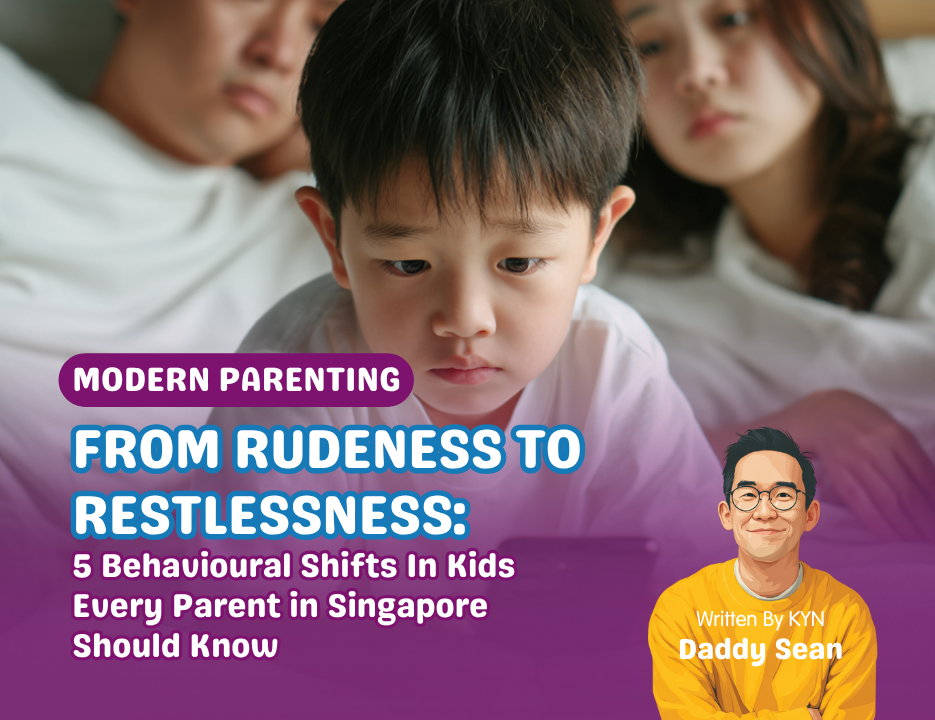Ever found yourself wondering, “Why does my kid talk like that?” or “Why can’t they just sit still for five minutes?”
You’re not alone. Many parents I’ve spoken to and honestly, myself included are noticing that kids today behave very differently from how we did growing up. They’re sharper, more outspoken, and digitally savvy, but also… easily distracted, emotionally reactive, and sometimes, a little too blunt for comfort.
Before we label them as rude or spoilt, it’s worth pausing to ask: what’s really going on beneath these behaviours?
Here are five rising behavioural shifts I’ve noticed among Singaporean kids and why they’re happening.
1. The Attention Crisis: Short Focus, Big Distractions
Screens are now a constant companion. Between online classes, YouTube, and mobile games, kids are overstimulated almost 24/7.
I’ve seen it with my own son, he can spend hours building worlds in Roblox, but loses interest in homework within minutes. It’s not that he’s lazy; his brain is wired to crave fast rewards.
When everything around them moves at lightning speed, it’s no wonder kids find it hard to sit still or focus. Their attention spans have shrunk not because they don’t care, but because the digital world is designed to keep them hooked.
What parents can do:
Try setting daily “digital downtime”, tech-free hours where the whole family unplugs. It’s not punishment; it’s a chance for their minds to slow down and breathe.
2. Emotional Overload: When Small Things Feel Big
Today’s kids feel a lot. They’re growing up in a fast-paced, high-expectation culture, juggling schoolwork, enrichment classes, and social pressure.
So when a toy breaks or plans change, the emotional meltdown that follows might seem “dramatic” but it’s often their way of releasing pent-up stress.
We adults have learned (sometimes the hard way) how to regulate emotions. Kids are still learning.
What parents can do:
Instead of reacting to the outburst, name the feeling. “You’re upset because you wanted that to work, right?”
It helps them feel understood and over time, they’ll learn to put words to their emotions instead of acting them out.
3. The Manners Gap: Rudeness or Social Rustiness?
It’s easy to think kids are becoming ruder. But many just haven’t had enough chances to practise real-world social interaction.
Texting, gaming chats, and online communication don’t teach tone, empathy, or eye contact. Add pandemic years of isolation, and you’ve got kids who struggle to read social cues.
What parents can do:
Don’t just tell them to “say hi” or “be polite” show them how. Model good manners yourself: greet the cleaner, thank the bus driver, make small talk with cashiers. Kids copy what they see more than what they hear.
4. The Silent Wall: When Kids Don’t Answer Back (Even When You Want Them To)
We often complain that kids talk back but silence can be just as worrying. Some children retreat because they’re anxious, afraid of being judged, or unsure what’s “safe” to say.
If your child clams up when you ask how school was, it’s not necessarily defiance. It could be anxiety or fear of disappointing you.
What parents can do:
Create low-pressure moments to connect car rides, bedtime chats, or during walks. Kids open up when they feel you’re listening, not interrogating.
5. The Awareness Drop: When Kids Stop Noticing Things
A growing number of parents tell me their kids don’t seem aware of their surroundings, walking while glued to a screen, forgetting to say thank you, or not noticing someone helping them.
It’s not that they’re unkind. Many kids today simply live in a world that moves for them. Parents, helpers, and teachers handle so much that children rarely need to observe, anticipate, or act on their own.
What parents can do:
Give them real-life tasks that build awareness, setting the table, packing their own bag, or helping carry groceries. These small acts teach mindfulness and gratitude in ways no lecture ever can.
The Bigger Picture
Our kids aren’t broken, they’re adapting to a world we never had to navigate at their age.
Yes, they may be more distracted or less patient, but they’re also more emotionally expressive, creative, and tech-savvy. The goal isn’t to “fix” them, it’s to help them find balance in this new environment.
At the end of the day, what children still crave most isn’t Wi-Fi or new gadgets. It’s connection. A parent who listens. A home that feels safe. A moment of real presence in a noisy world.
And that’s something we can all give, one mindful conversation at a time.
You might also want to check out some of our other articles that can help you navigate modern parenting challenges. For tips on recognising early signs of screen dependence, read Is Your Toddler Hooked on Screens? Here Are 5 Warning Signs. To learn how play can boost focus and emotional regulation, see How Joy Makes Us Better Parents: Lessons from Gabor Maté on the Power of Play. For guidance on building self-awareness and emotional intelligence in your child, check out Helping Kids Understand the Big Concept of Self-Acceptance. And don’t forget to join our community to share experiences and connect with other parents navigating similar challenges.
Hello! I am Daddy Sean

I am one of the editors of KidYouNot Parenting blogs! I have two adorable sons. I’m a nature lover who values wellbeing and mindful parenting. I’m all about creating balance, connection, and joy in family life.
Join KidYouNot SG Parenting Community
Sign up to become a member and gain access to exclusive parenting tips, special deals, and early updates on new products and events.
Follow us on Instagram and Telegram to connect with other parents, share your journey, and enjoy fun, supportive content every day!





